Carbon Derived from Jatropha Seed Hull as a Potential Green Adsorbent for Cadmium (II) Removal from Wastewater
Abstract
:1. Introduction
2. Experimental Section
2.1. Process of Producing the Adsorbent
2.2. Adsorption Experiment
2.3. Desorption Experiment
2.4. Characterization
2.5. Data Analysis
3. Results and Discussion
3.1. Characterization of Jatropha Seed Hull Carbon
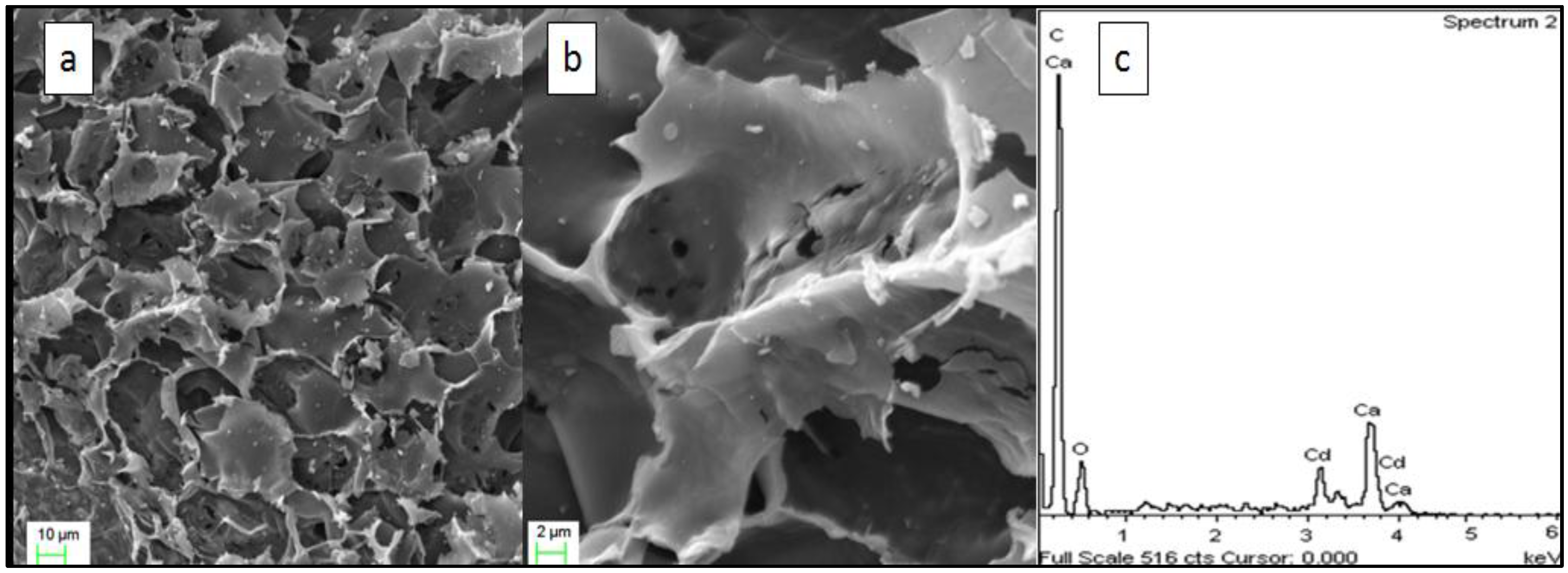
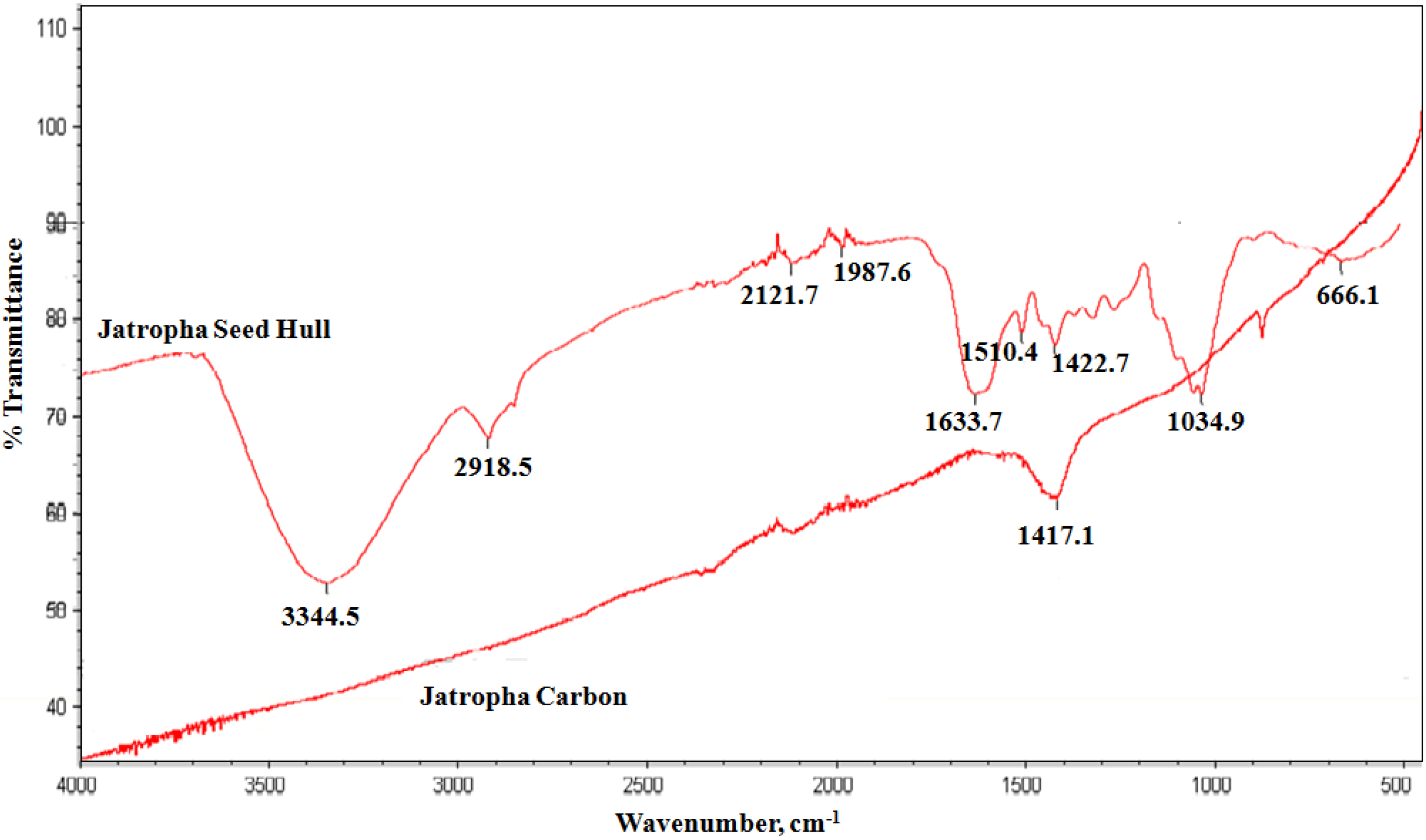
3.2. Kinetic Study
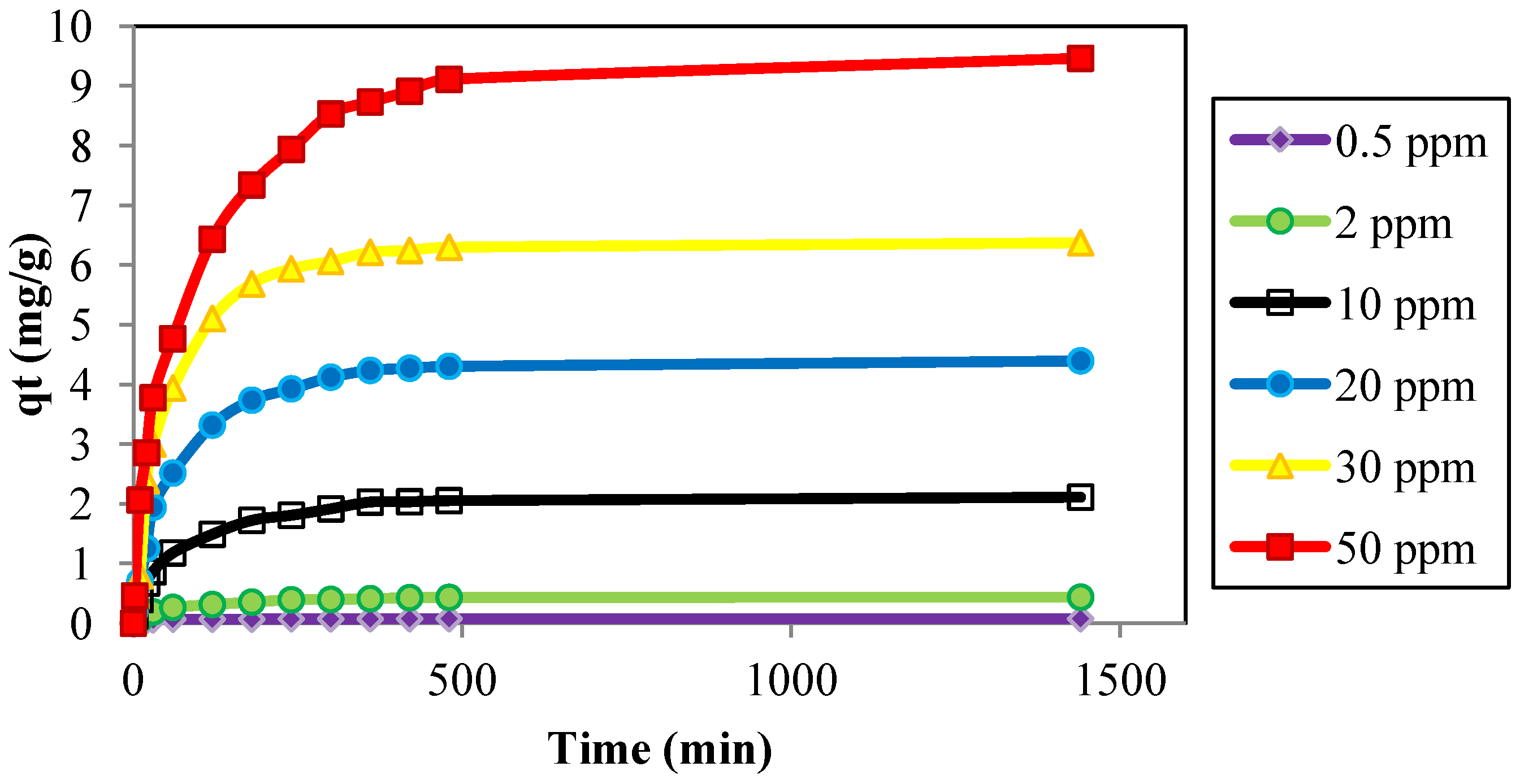
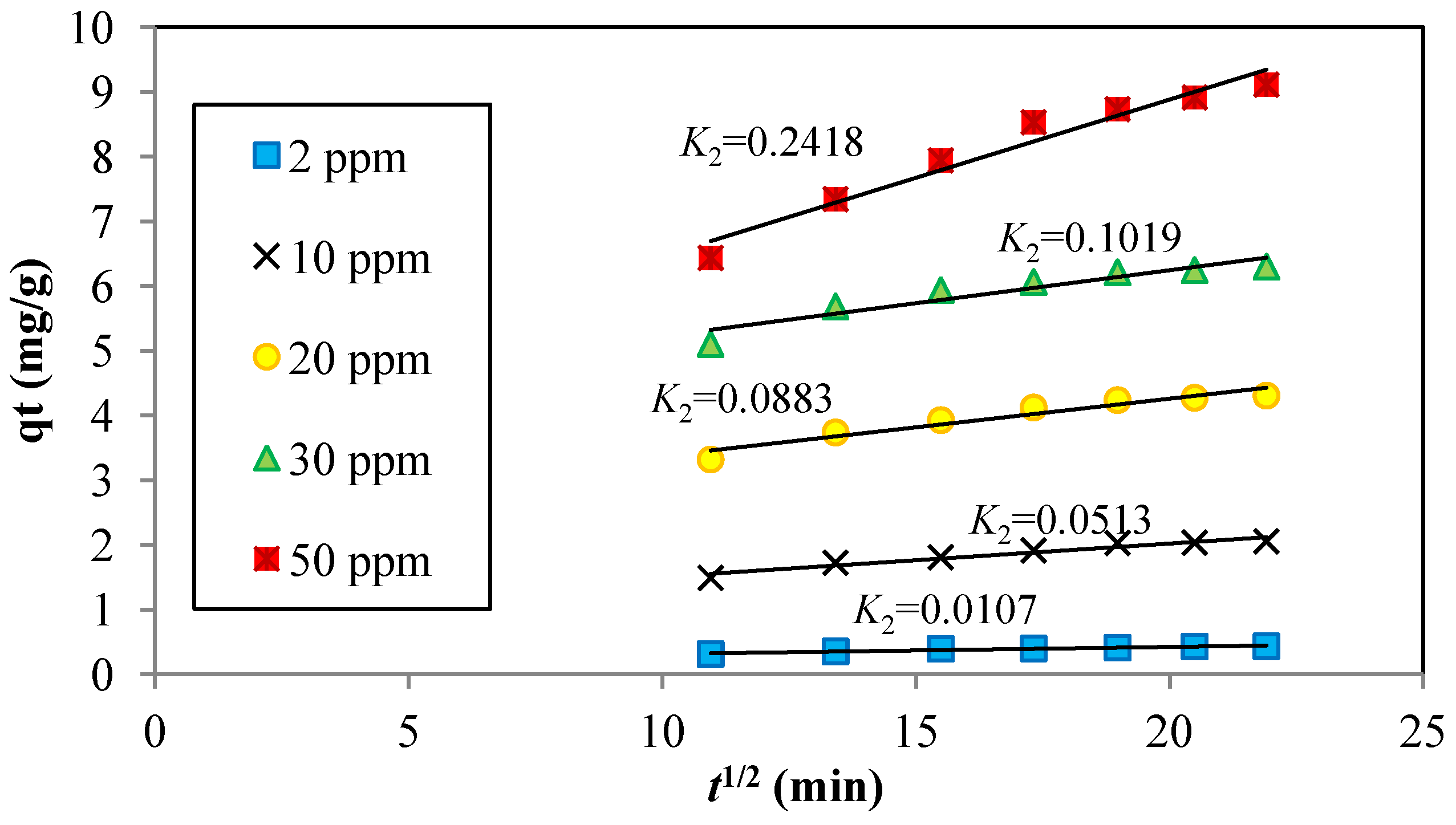
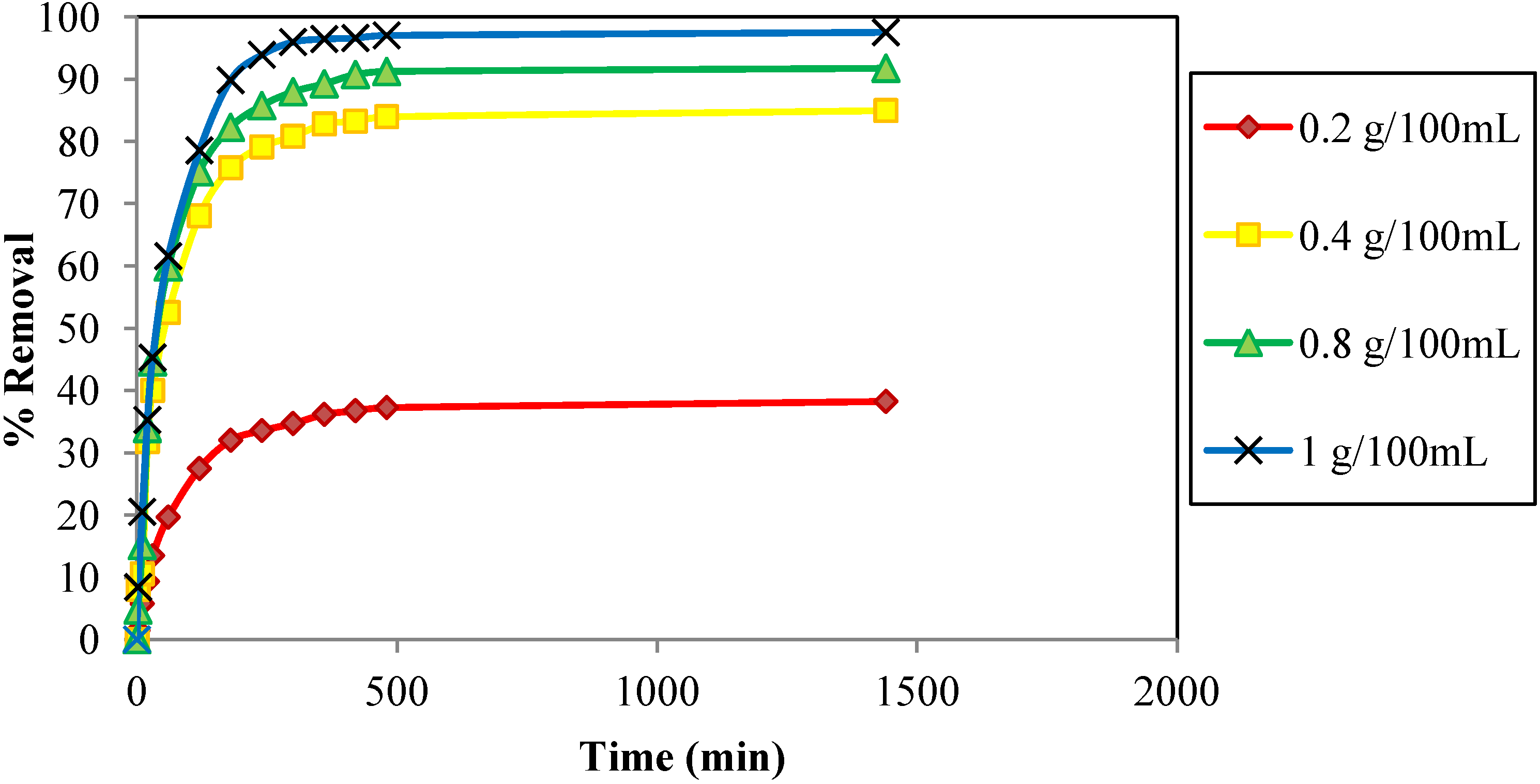
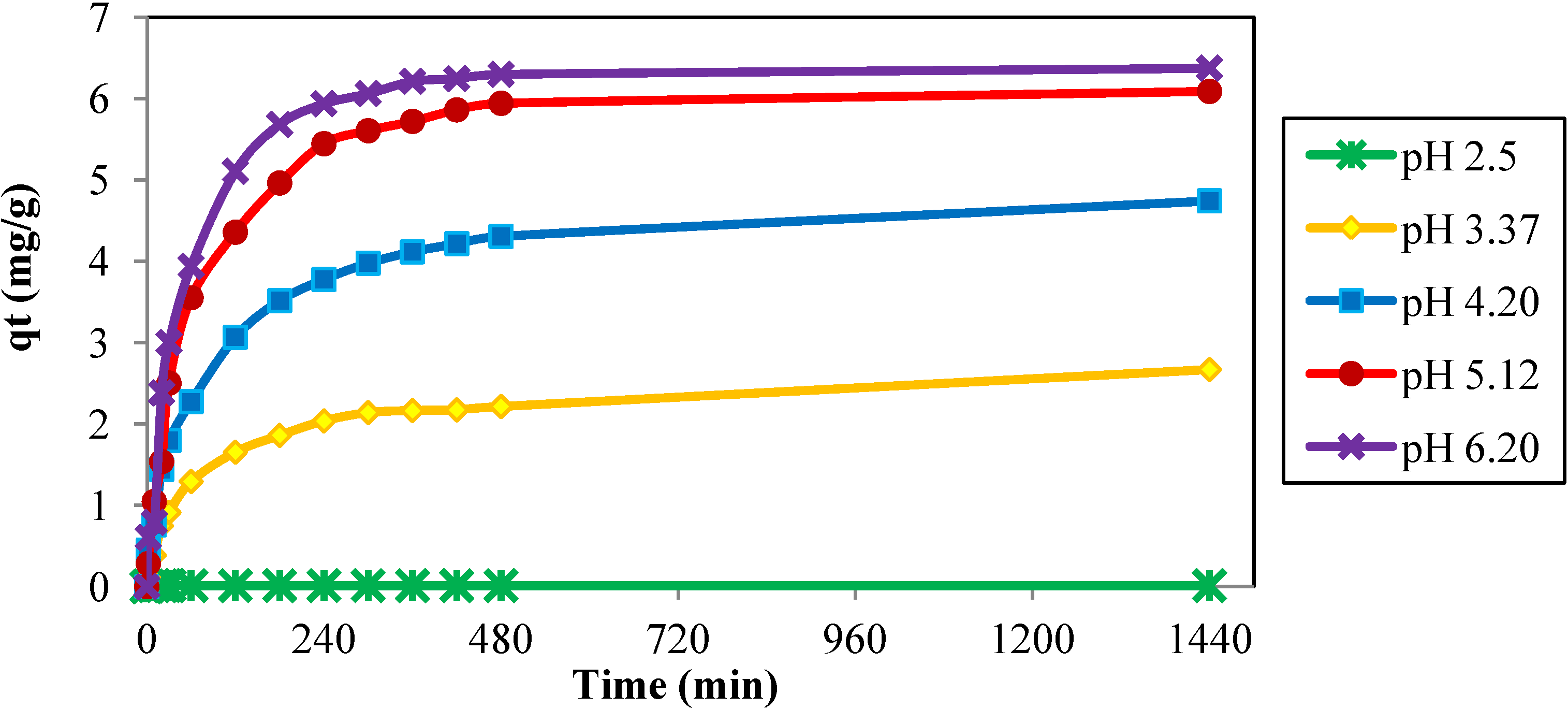
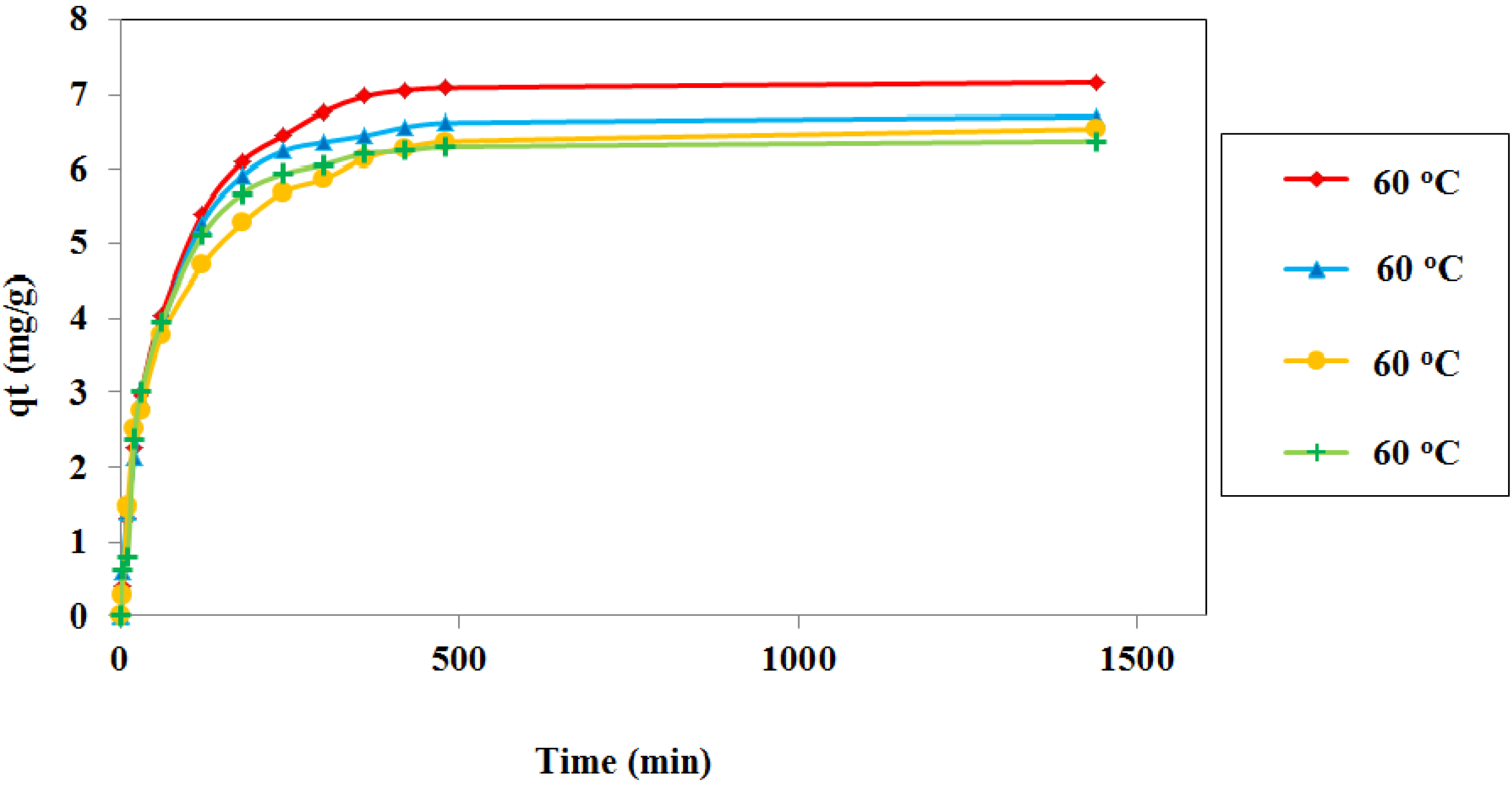
3.3. Dynamic Adsorption Study
| System parameters | Pseudo-first-order | Pseudo-second-order | |||||
|---|---|---|---|---|---|---|---|
| K1 | qe | R2 | K2 | qe | h | R2 | |
| Initial concentration | |||||||
| 0.5 ppm (mg/L) | 0.0085 | 0.0394 | 0.8534 | 0.9453 | 0.0763 | 0.0055 | 0.9985 |
| 2 ppm (mg/L) | 0.0090 | 0.3808 | 0.9736 | 0.0554 | 0.4589 | 0.0117 | 0.9921 |
| 10 ppm (mg/L) | 0.0076 | 1.7195 | 0.9842 | 0.0110 | 2.2051 | 0.0536 | 0.9928 |
| 20 ppm (mg/L) | 0.0081 | 3.5156 | 0.9861 | 0.0050 | 4.6860 | 0.1093 | 0.9934 |
| 30 ppm (mg/L) | 0.0092 | 4.8362 | 0.9837 | 0.1477 | 6.7705 | 0.1913 | 0.9911 |
| 50 ppm (mg/L) | 0.0067 | 7.6630 | 0.9892 | 0.1029 | 9.7182 | 0.2249 | 0.9913 |
| Initial Solution pH | |||||||
| pH 3.37 | 0.0037 | 2.0216 | 0.9026 | 0.0102 | 2.3883 | 0.0585 | 0.9936 |
| pH 4.20 | 0.0048 | 3.6610 | 0.9650 | 0.0055 | 4.5558 | 0.1134 | 0.9904 |
| pH 5.12 | 0.0076 | 4.9272 | 0.9870 | 0.0035 | 6.4309 | 0.1447 | 0.9925 |
| pH 6.20 | 0.0092 | 4.8362 | 0.9837 | 0.0042 | 6.7705 | 0.1913 | 0.9911 |
| Temperature | |||||||
| 26 °C | 0.0053 | 5.4425 | 0.9202 | 0.0042 | 6.7705 | 0.1913 | 0.9911 |
| 35 °C | 0.0090 | 5.2143 | 0.9859 | 0.0042 | 6.7522 | 0.1898 | 0.9938 |
| 45 °C | 0.0071 | 5.1286 | 0.9880 | 0.0042 | 7.0522 | 0.2113 | 0.9949 |
| 60 °C | 0.0092 | 4.8362 | 0.9837 | 0.0032 | 7.6687 | 0.1899 | 0.9939 |
| Dosage | |||||||
| 0.2 g | 0.0076 | 4.8040 | 0.8534 | 0.0031 | 6.1652 | 0.1177 | 0.9904 |
| 0.4 g | 0.0092 | 4.8362 | 0.9736 | 0.0042 | 6.7705 | 0.1913 | 0.9911 |
| 0.8 g | 0.0101 | 2.7340 | 0.9842 | 0.0080 | 3.6670 | 0.1071 | 0.9954 |
| 1.0 g | 0.0113 | 2.2636 | 0.9861 | 0.0107 | 3.1114 | 0.1040 | 0.9958 |
3.4. Isotherm Study
| Freundlich | Langmuir | |||||
|---|---|---|---|---|---|---|
| kf | 1/n | R2 | qm | kL | RL | R2 |
| 0.7264 | 0.8332 | 0.9605 | 20.7900 | 0.0730 | 0.2152–0.8727 | 0.9976 |
| No. | Adsorbents | qm | pH | Particle size (mm) | Temp. (°C) | Ref. |
|---|---|---|---|---|---|---|
| 1 | Physic seed hull | 11.90 | 6 | 0.6 | 24 | 6 |
| 2 | Castor hull | 6.98 | 5.8 | 0.6 | 23 | 7 |
| 3 | Granular activated carbon | 1.39 | 5.8 | 1.18 | 23 | 7 |
| 4 | Olive stone | 128.2 | 4 | 0.25 | 24 | 31 |
| 5 | Oak wood char | 0.37 | 5 | 0.6–0.25 | 25 | 33 |
| 6 | Pine bark char | 0.34 | 5 | 0.6–0.25 | 25 | 33 |
| 7 | Oak bark char | 5.40 | 5 | 0.6–0.25 | 25 | 33 |
| 8 | Carbon F-400 | 8.00 | 5 | 0.6–0.25 | 25 | 33 |
| 9 | Perlite | 0.42 | 6 | 2–1.7 | 22 | 37 |
| 10 | Ceiba petandara hull a.c. | 19.5 | 6 | 0.149 | 30 | 38 |
| 11 | Sawdust | 41.21 | 8 | – | 20 | 39 |
| 12 | JC | 20.79 | 6 | 0.5 | 24 | Present work |

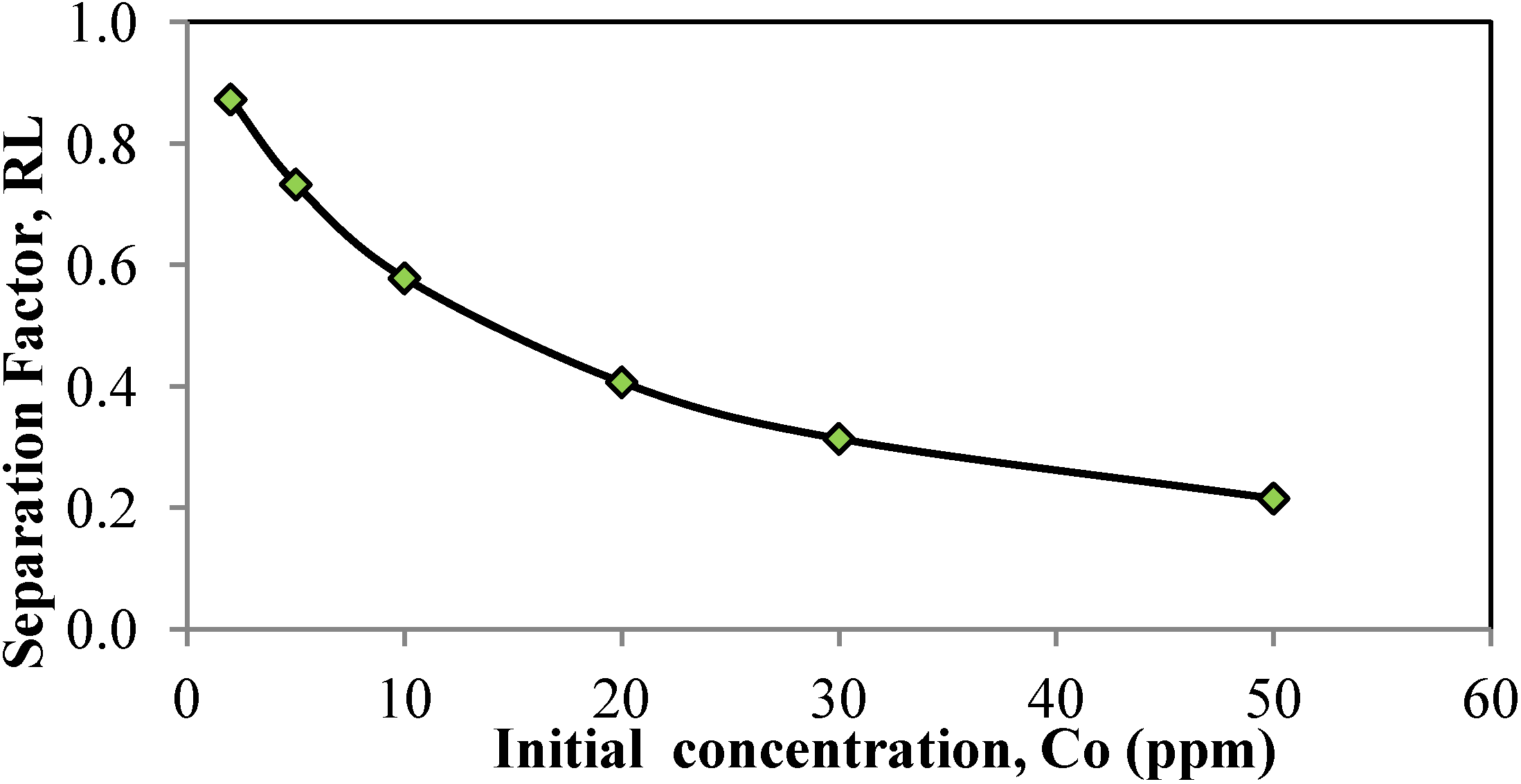
3.5. Desorption Study
4. Conclusions
Acknowledgments
Conflicts of Interest
References
- Heller, J. Promoting the Conservation and Use of Underutilized and Neglected Crops. 1. In Physic Nut. Jatropha curcas L.; International Plant Genetic Resources Institute: Rome, Italy, 1996. [Google Scholar]
- Ye, M.; Li, C.; Francis, G.; Makkar, H.R.P.S. Current situation and prospects of Jatropha curcas as a multipurpose tree in China. Agrofor. Syst. 2009, 76, 487–497. [Google Scholar] [CrossRef]
- Kaushik, K.; Kumar, K.; Kumar, S.; Kaushik, N.; Roy, S. Genetic variability and divergence studies in seed traits and oil content of jatropha (Jatropha curcas L.) accessions. Biomass Bioenergy 2007, 31, 497–502. [Google Scholar] [CrossRef]
- Mohammad, M. Studies on the Adsorption of Heavy Metal Ions and Dye from Aqueous Solution Using Physic Seed Hull (Jatropha curcas L.). Ph.D. Thesis, Universiti Teknologi Petronas, Perak, Malaysia, 2010. [Google Scholar]
- Mohammad, M.; Sen, T.K.; Maitra, S.; Dutta, B.K. Removal of Zn (II) from aqueous solution using castor seed hull. Water Air Soil Pollut. 2010, 215, 609–620. [Google Scholar] [CrossRef]
- Mohammad, M.; Maitra, S.; Ahmad, N.; Bustam, A.; Sen, T.K.; Dutta, B.K. Metal ion removal from aqueous solution using physic seed hull. J. Hazard. Mater. 2010, 179, 363–372. [Google Scholar] [CrossRef]
- Sen, T.K.; Mohammad, M.; Maitra, S.; Dutta, B.K. Removal of cadmium from aqueous solution using castor seed hull: A kinetic and equilibrium study. CLEAN Soil Air Water 2010, 38, 850–858. [Google Scholar] [CrossRef]
- Sen, T.K.; Sarzali, M.V. Removal of cadmium metal ion (Cd2+) from its aqueous solution by aluminium oxide (Al2O3): A kinetic and equilibrium study. Chem. Eng. J. 2008, 142, 256–262. [Google Scholar] [CrossRef]
- Corami, A.; Mignardi, S.; Ferrini, V. Cadmium removal from single- and multi-metal (Cd + Pb + Zn + Cu) solutions by sorption on hydroxyapatite. J. Colloid Interface Sci. 2008, 317, 402–408. [Google Scholar] [CrossRef] [PubMed]
- Zhu, C.; Luan, Z.; Wang, Y.; Shau, X. Removal of cadmium from aqueous solution by adsorption on granular red mud 9GRM. Sep. Purif. Technol. 2007, 57, 167. [Google Scholar] [CrossRef]
- Perez-Marin, A.B.; Meseguer, Z.V.; Ortuno, J.F.; Aguilar, M.; Saez, J.; Llorens, M. Removal of cadmium from aqueous solutions by adsorption onto orange waste. J. Hazard. Mater. 2007, 139, 122–131. [Google Scholar] [CrossRef]
- McCabe, W.; Smith, J.C.; Harriott, P. Unit Operations of Chemical Engineering; McGraw-Hill: New York, NY, USA, 1993. [Google Scholar]
- Ragnarsdottir, K.V. The Oxford Companion to the Earth; Hancock, P.L., Skinner, B.J., Dineley, D.L., Eds.; Oxford University Press: New York, NY, USA, 2000. [Google Scholar]
- Daintith, J. A Dictionary of Physics; Oxford University Press: New York, NY, USA, 2000. [Google Scholar]
- McKay, G. Design models for adsorption systems in wastewater treatment. J. Chem. Technol. Biotechnol. 1981, 81, 717–731. [Google Scholar] [CrossRef]
- Jumasiah, A.; Chuah, T.G.; Gimbon, J.; Choong, T.S.Y.; Azni, I. Adsorption of basic dye onto palm kernel shell activated carbon: Sorption equilibrium and kinetics studies. Desalination 2005, 186, 57–64. [Google Scholar] [CrossRef]
- Jain, A.K.; Gupta, V.K.; Bhatnagar, A.; Suhas. Utilization of industrial waste products as adsorbents for the removal of dyes. J. Hazard. Mater. 2003, 101, 31–42. [Google Scholar] [CrossRef] [PubMed]
- Ho, Y.S.; McKay, G. Sorption of dyes and copper ions onto biosorbents. Process Biochem. 2003, 38, 1047–1061. [Google Scholar] [CrossRef]
- Chang, C.F.; Chang, C.Y.; Tsai, W.T. Effects of burn-off and activation temperature on preparation of activated carbon from corn cob agrowaste by CO2 and steam. J. Colloid Interface Sci. 2000, 232, 45–49. [Google Scholar] [CrossRef] [PubMed]
- Duan, X.; Srinivasakannan, C.; Peng, J.; Zhang, L.; Zhang, Z. Preparation of activated carbon from jatropha hull with microwave heating: Optimization using response surface methodology. Fuel Process. Technol. 2010, 92, 394–400. [Google Scholar]
- Viboon, S.; Chiravoot, P.; Duangdao, A.; Duangduen, A. Preparation and characterization of activated carbon from the pyrolysis of physic nut (Jatropha curcas L.) waste. Energy Fuel 2008, 22, 31–37. [Google Scholar] [CrossRef]
- Ramakrishnan, K.; Namasivayam, C. Development and characterstics of activated carbons from jatropha husk, an agro industrial solid waste, by chemical activation methods. J. Environ. Eng. Manag. 2009, 19, 173–178. [Google Scholar]
- Namasivayam, C.; Sangeetha, D.; Gunasekaran, R. Removal of anions, heavy metals, organics and dyes from water by adsorption onto a new activated carbon from jatropha husk, an agro-industrial solid waste. Process Saf. Environ. Prot. 2007, 85, 181–184. [Google Scholar] [CrossRef]
- Weber, W.J.; Morris, J.C. Kinetics of adsorption on carbon from solution. J. Sanit. Eng. Div. Am. Soc. Civ. Eng. 1963, 89, 31–60. [Google Scholar]
- Lagergren, S. About the theory of so-called adsorption of soluble substances. Handlingar 1898, 24, 1–39. [Google Scholar]
- McKay, G. Use of Adsorbents for the Removal of Pollutants from Wastewaters; CRC Press: Boca Raton, FL, USA, 1996. [Google Scholar]
- Langmuir, I. The adsorption of gases on plane surfaces of glass, mica, and platinum. J. Am. Chem. Soc. 1918, 40, 1361–1403. [Google Scholar] [CrossRef]
- Adamson, A.W. Physical Chemistry of Surfaces, 2nd ed.; Interscience Publishers Inc.: New York, NY, USA, 1967. [Google Scholar]
- Freundlich, H. Colloid and Capillary Chemistry; Metheun: London, UK, 1926. [Google Scholar]
- Barton, T.J.; Bull, L.M.; Klemperer, W.G.; Loy, D.A.; McEnaney, B.; Misono, M.; Monson, P.A.; Pez, G.; Scherer, G.W.; Vartuli, J.C.; et al. Tailored porous materials. Chem. Mater. 1999, 11, 2633–2656. [Google Scholar] [CrossRef]
- Aziz, A.; Mohand, S.O.; El Hadj, E.; Menorval, L.C.D.; Lindheimer, M. Chemically modified olive stone: A low-cost sorbent for heavy metals and basic dyes removal from aqueous solutions. J. Hazard. Mater. 2009, 163, 441–447. [Google Scholar] [CrossRef] [PubMed]
- Jindarom, C.; Meeyoo, V.; Kitiyanan, B.; Rirksomboon, T.; Rangsunvigit, P. Surface characterization and dye adsorptive capacities of char obtained from pyrolysis/gasification of sewage sludge. Chem. Eng. J. 2007, 133, 239–246. [Google Scholar] [CrossRef]
- Mohan, D.; Pittman, C.U., Jr.; Bricka, M.; Smith, F.; Yancey, B.; Mohammad, J.; Steele, P.; Alexandre-Franco, M.F.; Gómez-Serrano, V.; Gong, H. Sorption of arsenic, cadmium, and lead by chars produced from fast pyrolysis of wood and bark during bio-oil production. J. Colloid Interface Sci. 2007, 310, 57–73. [Google Scholar] [CrossRef] [PubMed]
- Garg, U.; Kaur, M.P.; Jawa, G.K.; Sud, D.; Garg, V.K. Removal of cadmium (II) from aqueous solutions by adsorption on agricultural waste biomass. J. Hazard. Mater. 2008, 154, 1149–1157. [Google Scholar] [CrossRef] [PubMed]
- Zheng, W.; Li, X.M.; Wang, F.; Yang, Q.; Deng, P.; Zeng, G.M. Adsorption removal of cadmium and copper from aqueous solution by areca-a food waste. J. Hazard. Mater. 2008, 157, 490–495. [Google Scholar] [CrossRef] [PubMed]
- Tsai, W.T.; Chen, H.R. Removal of malachite green from aqueous solution using low-cost chlorella-based biomass. J. Hazard. Mater. 2010, 175, 844–849. [Google Scholar] [CrossRef] [PubMed]
- Mathialagan, T.; Viraraghavan, T. Adsorption of cadmium from aqueous solutions by perlite. J. Hazard. Mater. 2002, 94, 291–303. [Google Scholar] [CrossRef] [PubMed]
- Rao, M.M.; Ramesh, A.; Rao, G.P.C.; Seshaiah, K. Removal of copper and cadmium from the aqueous solutions by activated carbon derived from Ceiba pentandra hull. J. Hazard. Mater. 2006, 129, 123–129. [Google Scholar]
- Albadarin, A.B.; Mangwandi, C.; Walker, G.M.; Allen, S.J.; Ahmad, M.N. Biosorption characteristics of sawdust for the removal of Cd(II) ions: Mechanism and thermodynamic studies. Chem. Eng. Trans. 2011, 24, 1297–1302. [Google Scholar]
- Hall, K.R.; Eagleton, L.C.; Acrivos, A.; Vermeulen, T. Pore and solid diffusion kinetics in fixed-bed adsorption under constant-pattern conditions. Ind. Eng. Chem. Fundam. 1966, 5, 212–223. [Google Scholar] [CrossRef]
© 2013 by the authors; licensee MDPI, Basel, Switzerland. This article is an open access article distributed under the terms and conditions of the Creative Commons Attribution license (http://creativecommons.org/licenses/by/3.0/).
Share and Cite
Mohammad, M.; Yaakob, Z.; Abdullah, S.R.S. Carbon Derived from Jatropha Seed Hull as a Potential Green Adsorbent for Cadmium (II) Removal from Wastewater. Materials 2013, 6, 4462-4478. https://doi.org/10.3390/ma6104462
Mohammad M, Yaakob Z, Abdullah SRS. Carbon Derived from Jatropha Seed Hull as a Potential Green Adsorbent for Cadmium (II) Removal from Wastewater. Materials. 2013; 6(10):4462-4478. https://doi.org/10.3390/ma6104462
Chicago/Turabian StyleMohammad, Masita, Zahira Yaakob, and Siti Rozaimah Sheikh Abdullah. 2013. "Carbon Derived from Jatropha Seed Hull as a Potential Green Adsorbent for Cadmium (II) Removal from Wastewater" Materials 6, no. 10: 4462-4478. https://doi.org/10.3390/ma6104462




